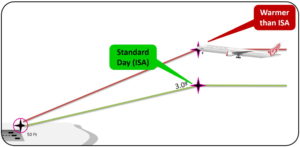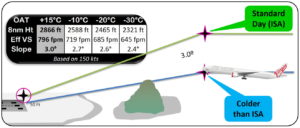I’ve been looking at Cold Temperature Altimetry Corrections in anticipation of potentially operating into such environments again in the near future. While my professional past includes operating the 777 to Moscow, Baku, Seuol, Beijing and a few other cold temperature destinations – most of the last decade has been focussed on Australia, Los Angeles, and the UAE. As such it’s been quite a while since cold temperature corrections have reared their ugly head – let alone metric altimetry. To say I haven’t really missed them is understating it.
Update 26.Jun.17 : Correcting Altitudes on APV – a Cluster
This one’s for you, Alex AFR!
The last week has been a whirlwind of contradictory opinions and conflicting manufacturer and regulatory guidance in this area. I am now firmly of the belief that I have no answer to the following questions (but I’m continuing to chase down something concrete, and definitive).
- EASA guidance (AMC CAT.OP.MPA.126 (d) (2) Ii) (B), recently published) specifically prohibits changes to the FAF/FAP and DA/H (as opposed to “Minima” which would include MDA). From this document, correction to altitudes is not required from (and including) the FAP through to the MAP. Prior to final approach and the missed approach still requires correction.
- Previous EASA guidance (AMC 20-27A App4 1.2 ) required corrections for initial, intermediate, missed approach – and the DA/H.
- This document (2.6.1.5) assumes that cold temp corrections have been made to the DA/H on APV.
- The documentation provided by two Middle Eastern airlines to their respective crews conforms to this guidance. A highly respected Asian carrier however still corrects the minima on APV. My own airline conforms to the EASA guidance – no correction.
- Meanwhile, there are FAA and several other regulators to do provide guidance on correcting the minima for APV.
- That said, if you do not correct the minima on APV, I cannot find documentation that guarantees terrain clearance in the transition from the temperature independent obstacle protected final approach slope – into the temperature sensitive, correction required missed approach. Hence if you don’t correct the minima on an APV, you will be lower on approach – are you guaranteed obstacle clearance as you transition into the missed approach, with it’s requirement to correct temperatures?
- The Middle Eastern carriers correct minima at 0ºC and below; and Terminal, Initial, Intermediate, Final (where necessary) and Missed Approach altitudes at -30ºC and below – with no clear explanation of why temperatures in between are ignored. There is some justification for this in the Boeing FCOM – but I’m not convinced.
- Additionally the question occurs that if you correct your Intermediate constraint on an APV, but not your Final Fix (Point) altitude, your FMC commands a steeper (non CDFA) descent on the approach, and takes you below the minimum altitude between the IF and FAF. This would seem to be a clear violation of approach altitude constraints, and it’s unclear to me how you are protected at this point by the final approach slope inherent in APV approach design …
- And for Alex – on baro-compensated FMS such as the A380, what corrections are required at the FAP, Minima for APV approaches. The A380 presumeably is flying the temperature corrected slope, which means if you do not correct the minima, you’ll be flying further down that slope than you would in either an un-compenstated uncorrected APV or an ISA approach – that can’t be right, can it?
As you can see – THIS IS A CAN OF WORMS. I can’t believe that I’m struggling to understand and obtain clear guidance on something that we’ve been doing for Decades (at least). This is really pissing me off.
It’s possible that the latest documentation from EASA contains an error (that would be the simplest for me!); it’s also possible that the recent change from EASA corrects a previous error. Frack.
More to come … meanwhile …
I thought I had a pretty good grasp on the concept, but as I dove deeper down the rabbit hole and came up hard against the fundamentals of the FMC and VNAV PATH on final approach – I was back to basics in trying to sort out what is required. Fortunately, I had the help of good friends at several other airlines to aid me in my quest. While they have reviewed the following material – any mistakes in what comes next are mine.
As always, the following content is couched firmly in the area of my own “expertise” – Boeing, the B777(-300ER), my airline. Your mileage may vary – but as mentioned I have passed this in front of a number of other consummate professionals across the globe.
Cold Temperature Altimetry Corrections
Aircraft altimeters and altimetry systems are calibrated for ISA conditions. When the OAT deviates from ISA, an indication error occurs in the altimetry information provided to the pilots as well as the barometric altitude reference passed along to the FMC and other systems. The 777/FMC does not currently have the ability to correct for non-ISA temperature deviations.
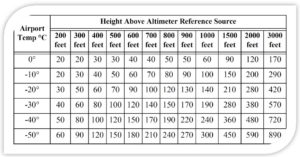 Deviations from ISA in terms of Altimetry are referenced against a ground-based temperature source, typically the temperature on the ground at the departure or destination airport. While it may not be entirely accurate, a uniform deviation is assumed from the ground to the level of the aircraft.
Deviations from ISA in terms of Altimetry are referenced against a ground-based temperature source, typically the temperature on the ground at the departure or destination airport. While it may not be entirely accurate, a uniform deviation is assumed from the ground to the level of the aircraft.
The size of cold temperature altimetry errors is proportional to:
- The degree of variation from ISA; and
- The height of the altitude being corrected above the ground temperature source (above airport elevation).
As shown here from the Boeing FCOM Supplementary Procedures, for a fixed deviation from ISA the correction required increases with altitude. For a fixed altitude, the correction required increases with height above the airfield. Note that ATC provided radar vector altitudes do not require pilot correction for cold temperature corrections.
Warmer the ISA
In warmer than ISA conditions, the altimetry system under-reads. When the aircraft is flown by reference to a barometric source (whether driven by the pilot/autopilot using the altimeter or the FMC using a barometric reference) the aircraft is invariably actually higher than indicated on the altimeter. An approximate rule of thumb is 0.3º of slope for every 15º of temperature above ISA.
For a Non-Precision Approach (whether driven by the pilot/autopilot using the altimeter or the FMC using a barometric reference) the aircraft will be higher than indicated. Since the error decreases with descent, the height above a 3 degree slope decreases until the aircraft is only a few feet above the required threshold crossing height. In effect the aircraft starts the approach high, descending on a steeper effective angle than promulgated by the instrument approach, which results in slightly higher descent rates and less thrust required. If a visual guidance system is provided the indications will show high on slope to the threshold (see below).
For Precision Approaches (whether ILS or GNSS based), the aircraft flies the commanded 3 degree (or otherwise) slope down to the runway and threshold crossing height. For such approaches, the altimeter will under-read since the aircraft is actually on slope, but the altimetry indications are impacted by the ISA deviation. This is often noticed at the outer marker crossing height check during precision approaches to warmer temperature airports. The minima will require correction for cold temperatures unless RA based (see below).
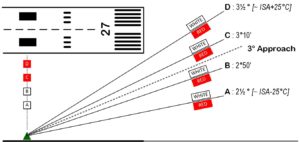 Boeing do not require corrections for warmer than ISA temperatures, and this information is provided for guidance only.
Boeing do not require corrections for warmer than ISA temperatures, and this information is provided for guidance only.
Visual Slope Guidance
From a barometric based approach, in non-standard ISA conditions, the aircraft will be higher (warmer) or lower (colder) than the promulgated instrument approach and any provided visual approach slope guidance system. The height error decreases as the aircraft reduces height above the ground and the aircraft approximates a steeper (warmer) or flatter (colder) approach path, which is maintained to the threshold. This deviation from the visual guidance system approach angle will be reflected in the visual approach slope systems indications.
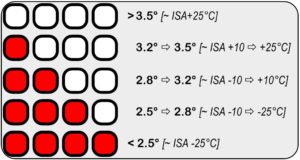 The values shown here are approximates for a PAPI system aligned at 3 degree slope and are for guidance only.
The values shown here are approximates for a PAPI system aligned at 3 degree slope and are for guidance only.
Correcting Minima (nearly all Approaches)
Precision (Cat 1) and Non-Precision Approaches (RNAV GNSS / RNP LNAV) based on barometric minima (both MDA and DH) require cold temperature corrections. You’re looking at your altimeter to to make your Continue/Don’t decision, and that altitude only provides obstacle clearance protection if it’s been cold temperature corrected.
NOTE : THERE IS (A LOT) OF CONTRADICTORY GUIDANCE ON (NON) CORRECTING FAF/FAP AND MINIMA ON APV. I’LL UPDATE TO WHAT I FINALLY BELIEVE IS CORRECT (WITH REFERENCES) WHEN I KNOW WHAT I FINALLY BELIEVE IS CORRECT!
The exception to this is APV (APproach with Vertical guidance) such as RNAV GNSS/GPS with LNAV/VNAV DH minima and RNP AR / RNP LNAV-VNAV approaches. Such approaches come with an operating temperature range on the chart (usu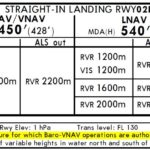 ally a minimum but often a min and max OAT). Down to the minimum temperature specified, the FAF and Minima (DH) are protected by a sloped obstacle clearance surface (OCS). There is no need to correct the minima for colder temperature altimetry, down to the minimum temp specified on the chart.
ally a minimum but often a min and max OAT). Down to the minimum temperature specified, the FAF and Minima (DH) are protected by a sloped obstacle clearance surface (OCS). There is no need to correct the minima for colder temperature altimetry, down to the minimum temp specified on the chart.
Note that Radio Altimeter (RA) based minima do not require cold temperature corrections.
Basic Modes using FPA in Non-Standard ISA Temperatures
When Flight Path Angle (FPA) is used in non-standard ISA temperature conditions, a higher approach angle (warmer conditions) or lower approach angle (colder conditions) is required to commence an approach from an un-corrected initial altitude. This is typically required for NPAs in high temperatures. For low temperature corrected NPAs the promulgated glide path angle should be used with FPA since the aircraft is at the corrected height above the runway, despite the altimeter indications.
Colder Than ISA
Here we go …
In colder than ISA conditions, the altimetry system over-reads. When the aircraft is flown by reference to a barometric source (whether driven by the pilot/autopilot using the altimeter or the FMC using a barometric reference) the aircraft is invariably actually lower than indicated. This can lead to unsafe clearance from terrain in relation to all minimum safe altitudes in the departure, arrival, approach and missed approach phases of flight. Boeing requires low temperature corrections when the ambient airport temperature is at or below 0C
SIDs and STARs
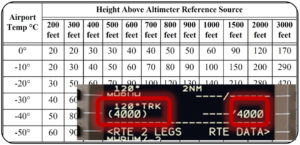 Minimum Safe Altitudes (MSA), Lowest Safe Altitudes (LSALT) and minimum altitudes on SIDs and STARs may need to be corrected in cold (Airport Temp At/Below 0º C) conditions. Corrections are based on the Boeing FCOM SP chart with extrapolation in accordance with the guidance provided. Corrections are made based on the ambient airport temperature and the height of the minimum altitude above the airfield elevation. Deviations from charted altitude constraints due cold temperature corrections must be communicated to ATC. Note that some FMC constraints cannot be cold temperature corrected (such as conditional altitudes).
Minimum Safe Altitudes (MSA), Lowest Safe Altitudes (LSALT) and minimum altitudes on SIDs and STARs may need to be corrected in cold (Airport Temp At/Below 0º C) conditions. Corrections are based on the Boeing FCOM SP chart with extrapolation in accordance with the guidance provided. Corrections are made based on the ambient airport temperature and the height of the minimum altitude above the airfield elevation. Deviations from charted altitude constraints due cold temperature corrections must be communicated to ATC. Note that some FMC constraints cannot be cold temperature corrected (such as conditional altitudes).
The FMC & VNAV PATH in Cold Temperatures
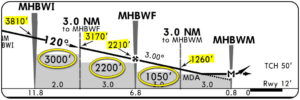 Outside of the CDU LEGS page final approach angle, the FMC drives VNAV vertical path commands through the use of the on-board barometric reference systems, which are subject to cold temperature errors. As such for all instrument approaches, if VNAV is going to be used the FMC LEGS page altitude constraints will require cold temperature corrections. Crew should appreciate the difference between adjusting these altitudes to ensure clearance from terrain (yellow ovals) vs restoring the programmed aircraft flight path to that intended by the approach design (yellow highlight).
Outside of the CDU LEGS page final approach angle, the FMC drives VNAV vertical path commands through the use of the on-board barometric reference systems, which are subject to cold temperature errors. As such for all instrument approaches, if VNAV is going to be used the FMC LEGS page altitude constraints will require cold temperature corrections. Crew should appreciate the difference between adjusting these altitudes to ensure clearance from terrain (yellow ovals) vs restoring the programmed aircraft flight path to that intended by the approach design (yellow highlight).
Strictly speaking, the Boeing FCOM requires corrections to altitude constraints, although correcting crossing altitudes is a similar procedure. Deviations from ATC cleared altitudes for cold temperature corrections must be communicated to ATC.
Once past the FAF, the FMC follows a path dictated by the geometric angle indicated in the LEGS page, as restricted by any constraining higher altitude in the LEGS page. However the FMC is fundamentally a barometrically driven device, and while a geometric angle is indicated on the LEGS page, in fact the FMC converts this to a barometric path based on the end of path lateral and vertical co-ordinates. As such the FMC flies the LEGS page slope by reference to altimetry, and is subject to temperature error. Since this error is magnified by deviation from ISA and height above the airport:
- In warmer conditions the FMC will start the final approach high, and fly a steeper slope.
- In colder conditions, the FMC will start the final approach low and fly a flatter slope.
 With corrected FAF (or later) altitude constraints, the FMC calculates a steeper approach angle to meet this increased constraint altitude requirement. Since the barometric temperature error reduces with descent, these corrections will result in the FMC approximating the original promulgated approach angle (while believing it is flying the steeper angle).
With corrected FAF (or later) altitude constraints, the FMC calculates a steeper approach angle to meet this increased constraint altitude requirement. Since the barometric temperature error reduces with descent, these corrections will result in the FMC approximating the original promulgated approach angle (while believing it is flying the steeper angle).
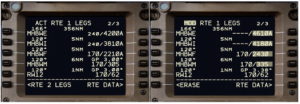 Constraints that typically require correction are At, At-or-Above, and At-or-Below. Below constraints do not require cold temperature corrections.
Constraints that typically require correction are At, At-or-Above, and At-or-Below. Below constraints do not require cold temperature corrections.
In Short :
While nominally on a glidepath – FMC / VNAV PTH flies a barometrically calculated glide path that is subject to non-ISA temperature altimetry error.
Approach with Vertical Guidance (APV) including RNP-AR
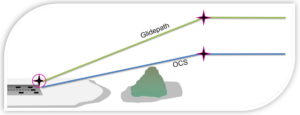 APV approaches differ from standard NPAs in that they are constructed similarly to precision approaches with a sloped Obstacle Assessment Surface (OCS) in the final approach, rather than the traditional step-down criteria shown on such charts. These approaches must be flown in LNAV and VNAV, typically to a Decision Altitude (DA) rather than an MDA.
APV approaches differ from standard NPAs in that they are constructed similarly to precision approaches with a sloped Obstacle Assessment Surface (OCS) in the final approach, rather than the traditional step-down criteria shown on such charts. These approaches must be flown in LNAV and VNAV, typically to a Decision Altitude (DA) rather than an MDA.
When these approaches are flown in cold temperature conditions, the final approach slope altitudes do not require correction, and the approach is flown from a lower FAF altitude on a shallower approach. The instrument approach chart includes a minimum ambient (airport) temperature below which the lower, flatter approach is not guaranteed to be clear of the OCS. When the ambient (airport) temperature is below the charted minimum, a reversion to LNAV only minima is usually available – but the charted LNAV/VNAV minima must no be used.
NOTE : THERE IS (A LOT) OF CONTRADICTORY GUIDANCE ON (NON) CORRECTING FAF/FAP AND MINIMA ON APV. I’LL UPDATE TO WHAT I FINALLY BELIEVE IS CORRECT (WITH REFERENCES) WHEN I KNOW WHAT I FINALLY BELIEVE IS CORRECT!
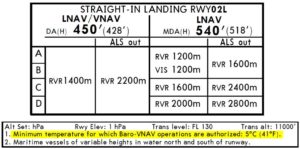 For APV approaches, cold temperature corrections are required to all altitudes outside the final approach – IAF, IF and other constraints as well as the Missed Approach. The FAF constraint does not require correction, nor any altitude constraint in the LEGS page after the FAF down to the Missed Approach Point (MAP). The minima while technically a barometric reference (you’re looking at an Altimeter) is protected by the OCS and so therefore does not require correction. On an APV in a cold temperature environment, you’re making your Continue/Don’t decision at a similar geographic location to an ISA approach, closer to the ground – but still clear of terrain (down to the minimum temperature on the chart.
For APV approaches, cold temperature corrections are required to all altitudes outside the final approach – IAF, IF and other constraints as well as the Missed Approach. The FAF constraint does not require correction, nor any altitude constraint in the LEGS page after the FAF down to the Missed Approach Point (MAP). The minima while technically a barometric reference (you’re looking at an Altimeter) is protected by the OCS and so therefore does not require correction. On an APV in a cold temperature environment, you’re making your Continue/Don’t decision at a similar geographic location to an ISA approach, closer to the ground – but still clear of terrain (down to the minimum temperature on the chart.
Ken.![]()

